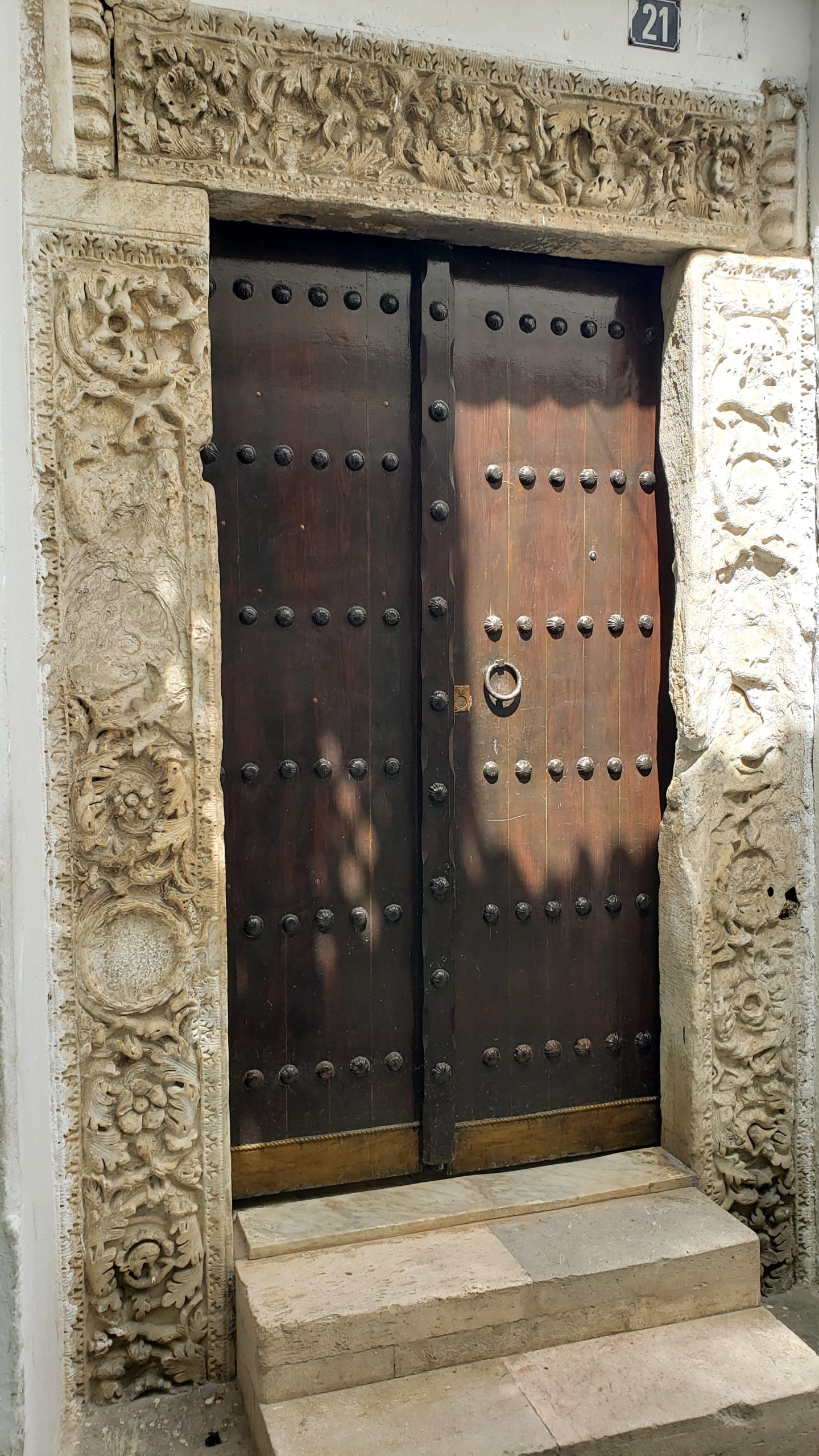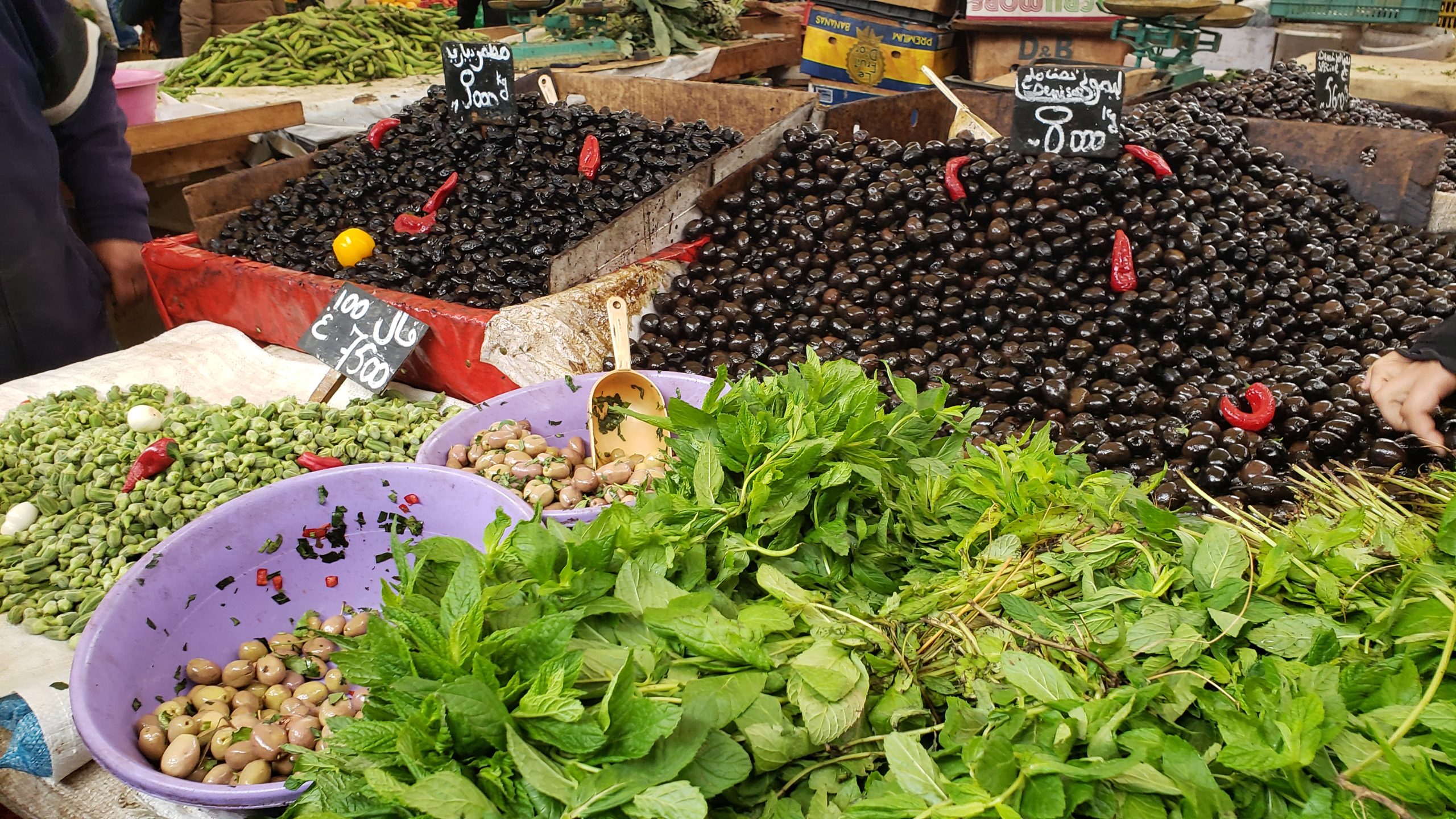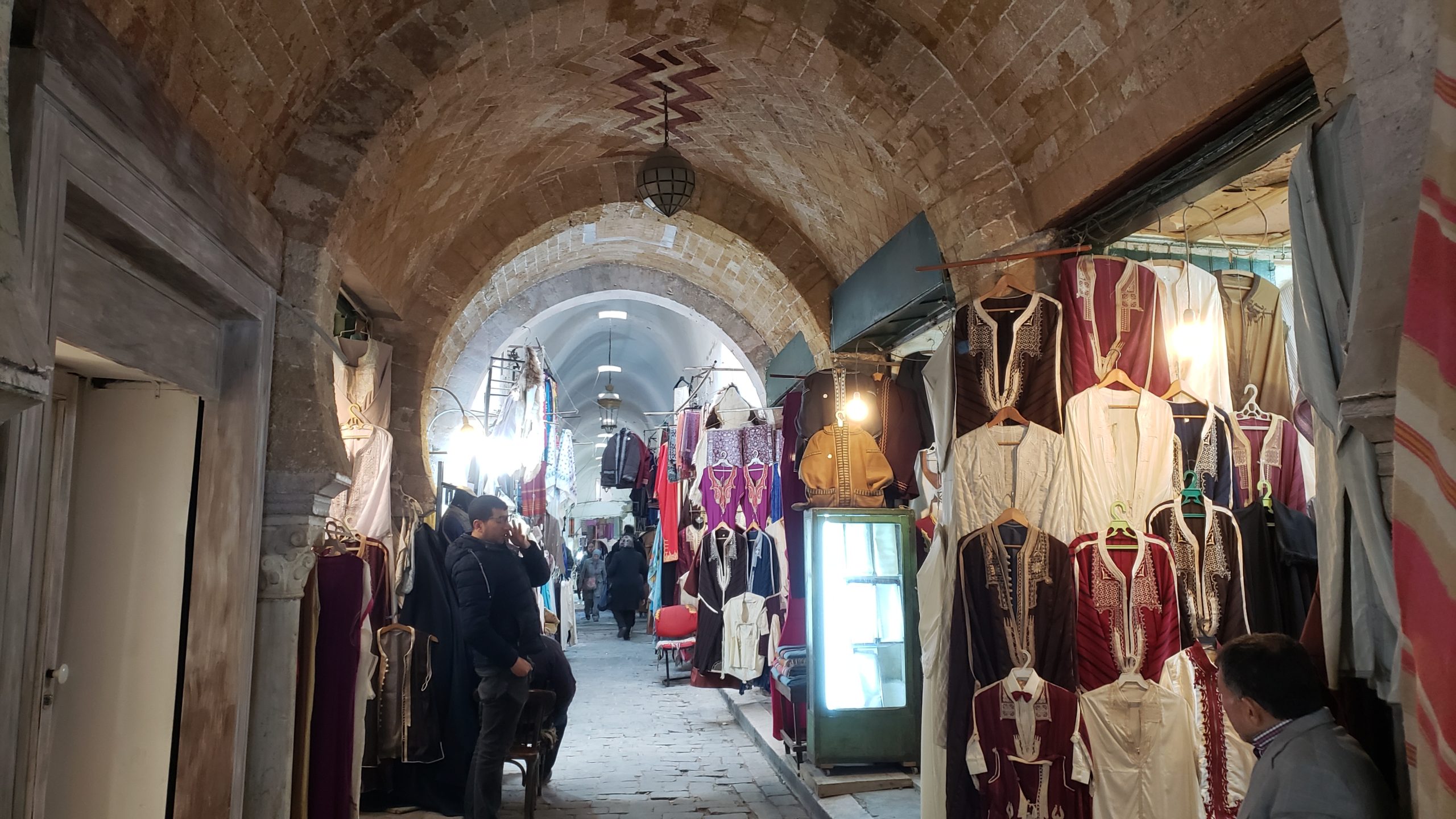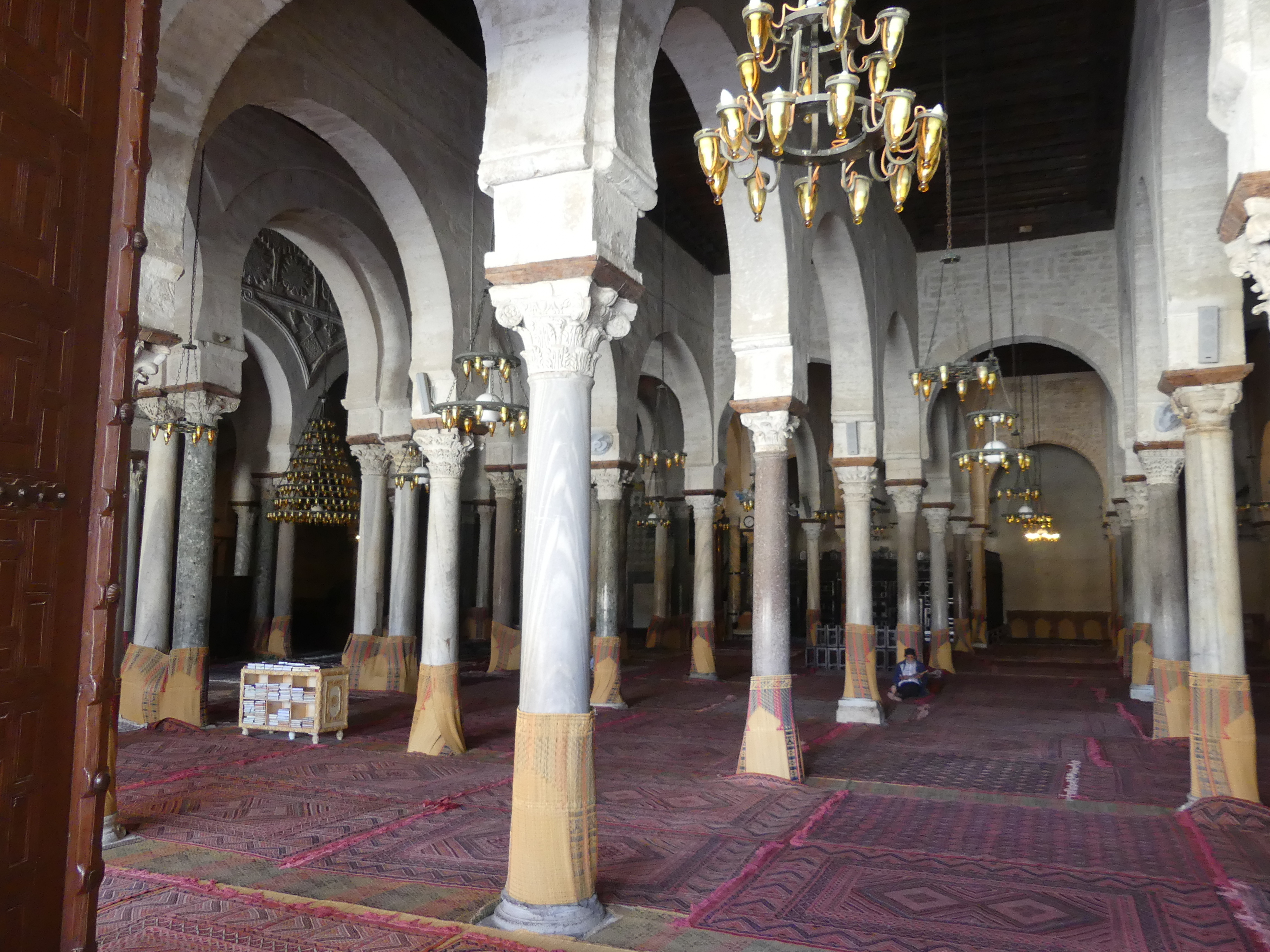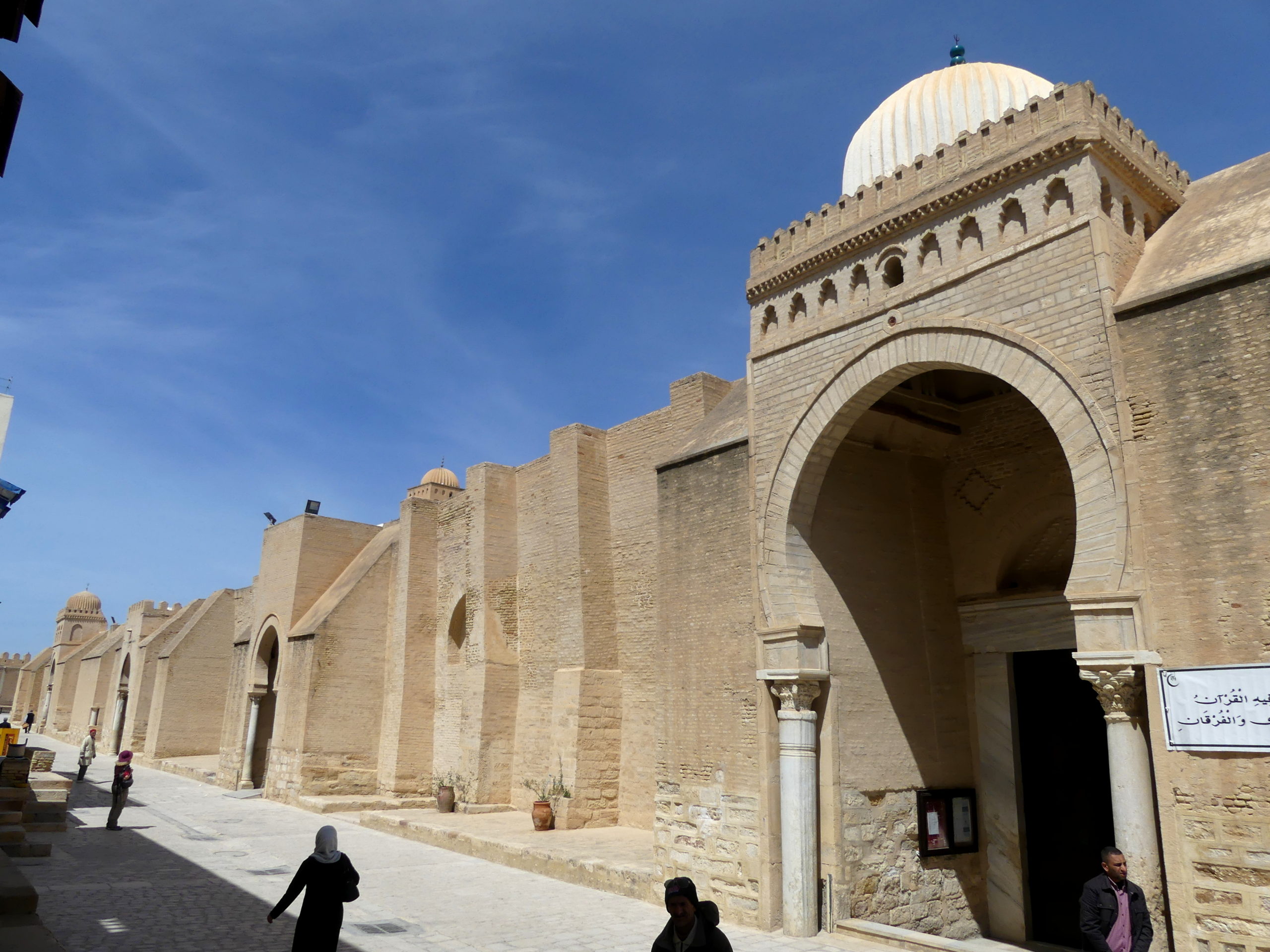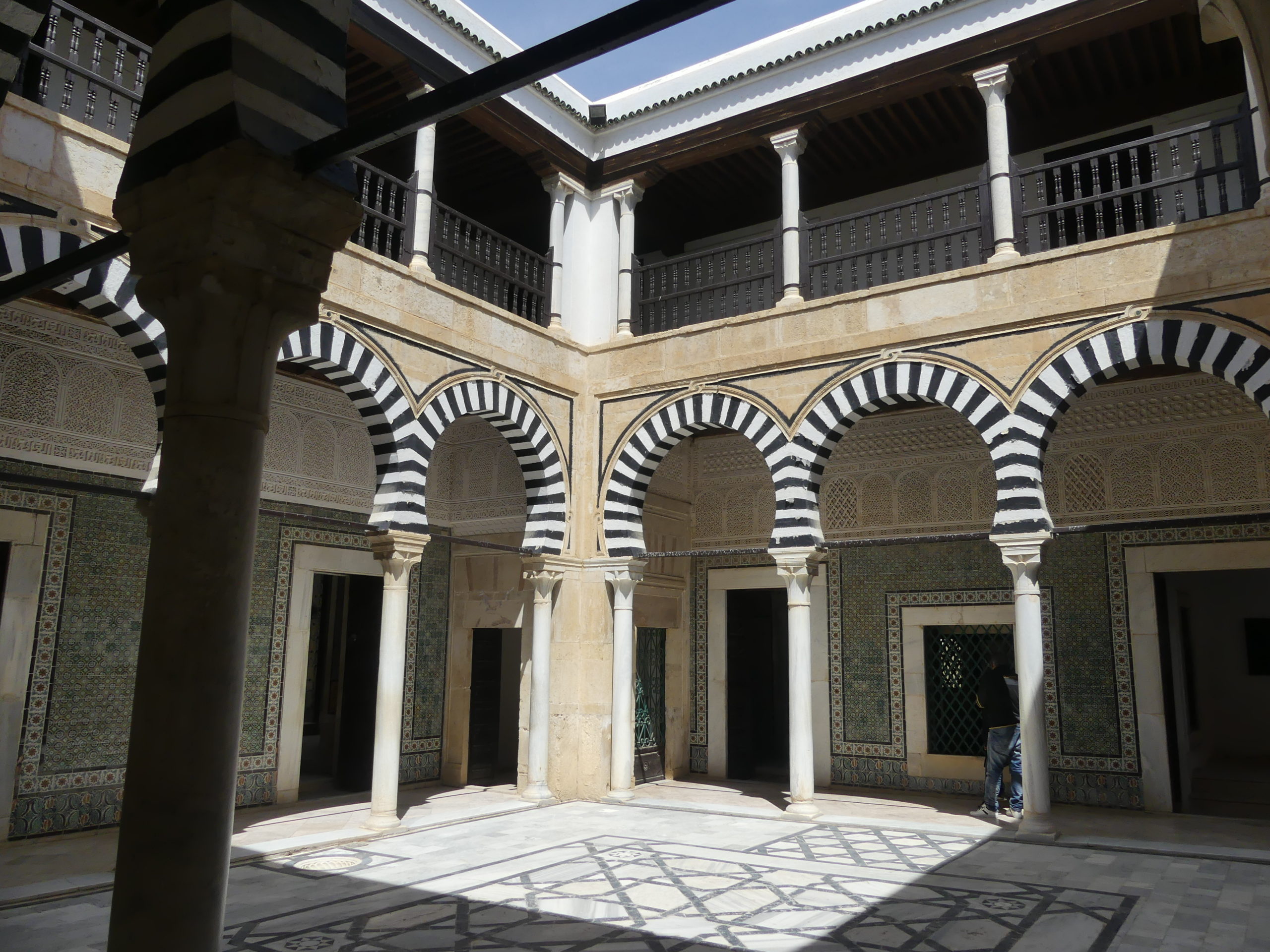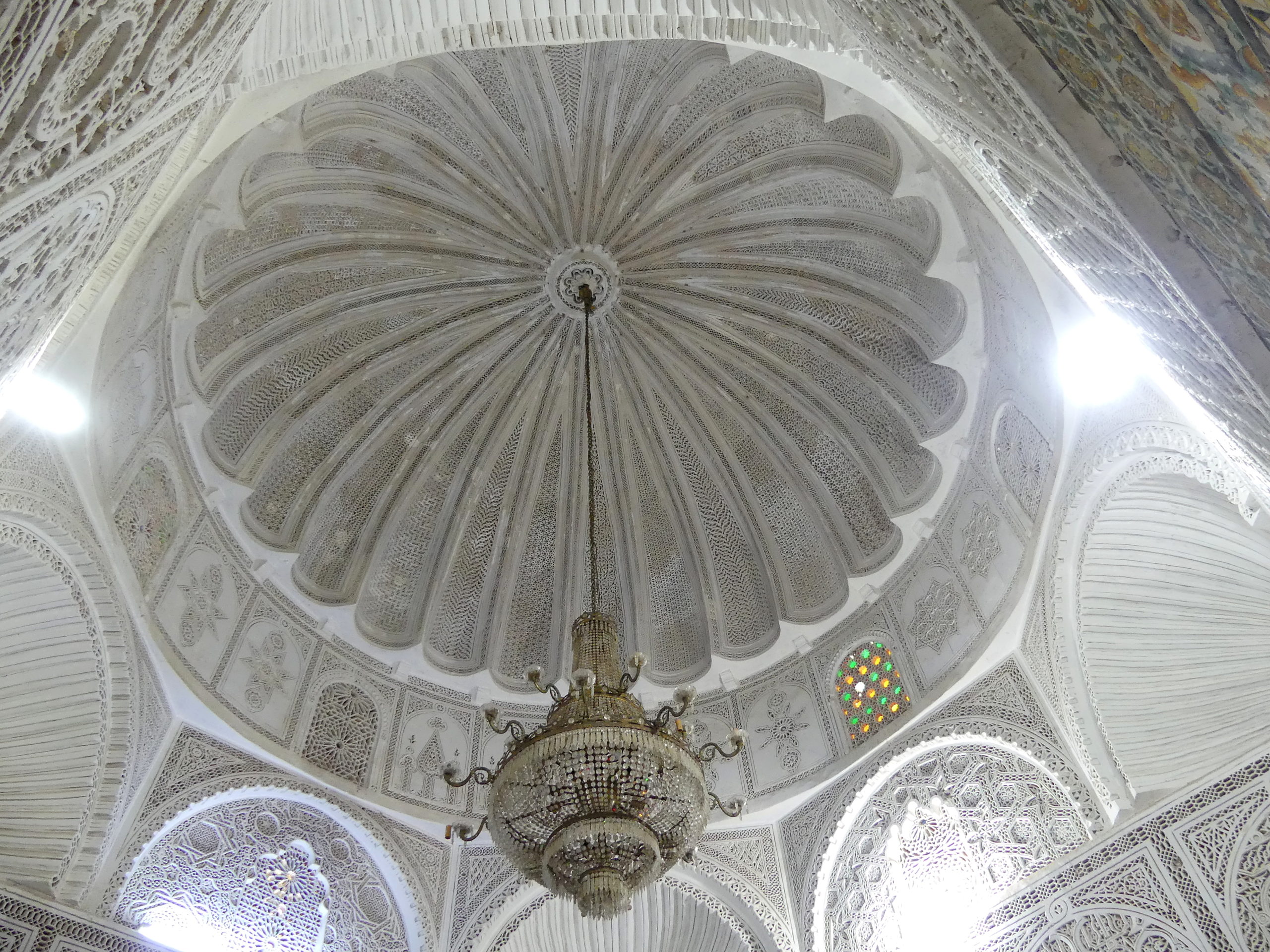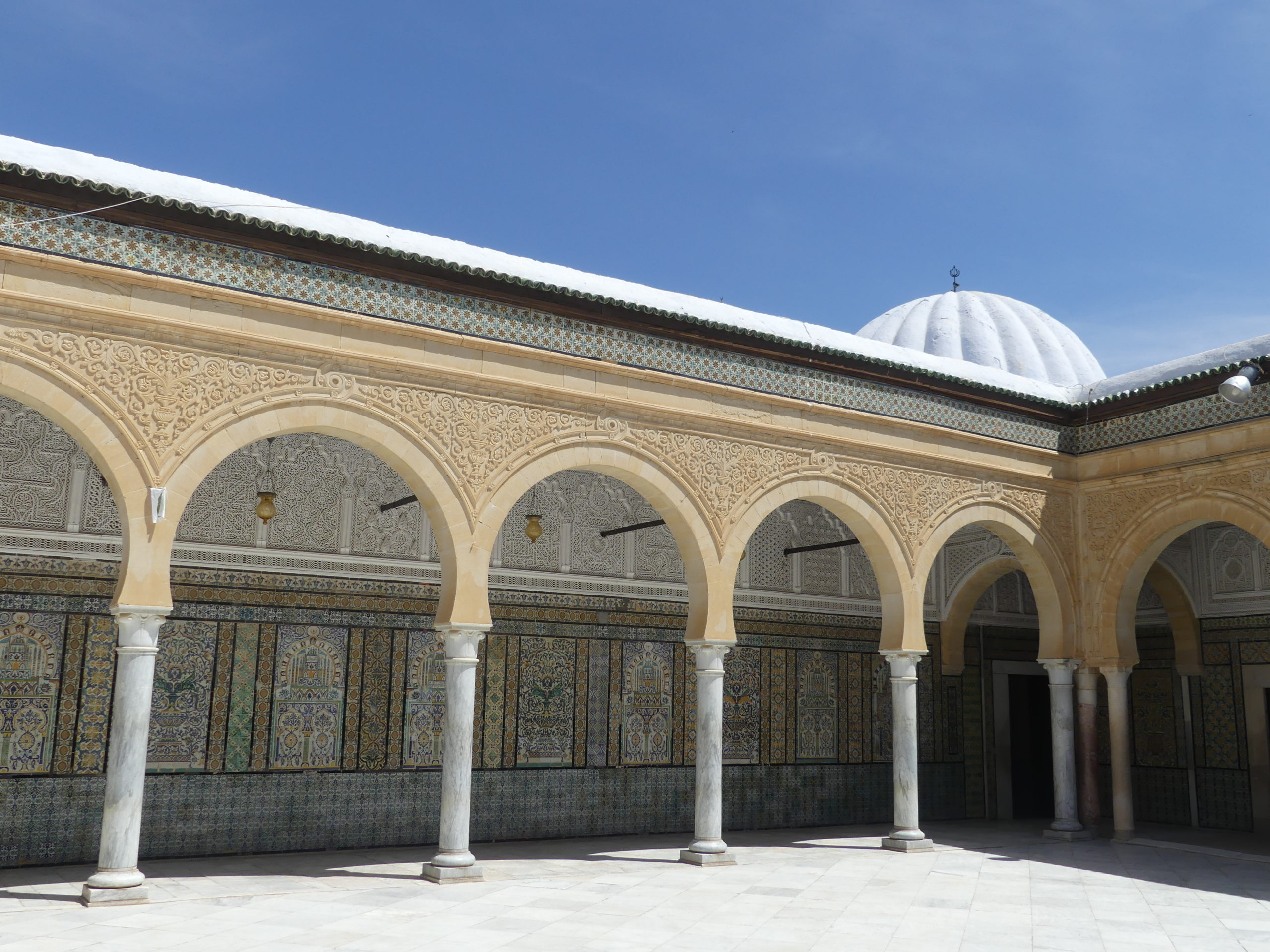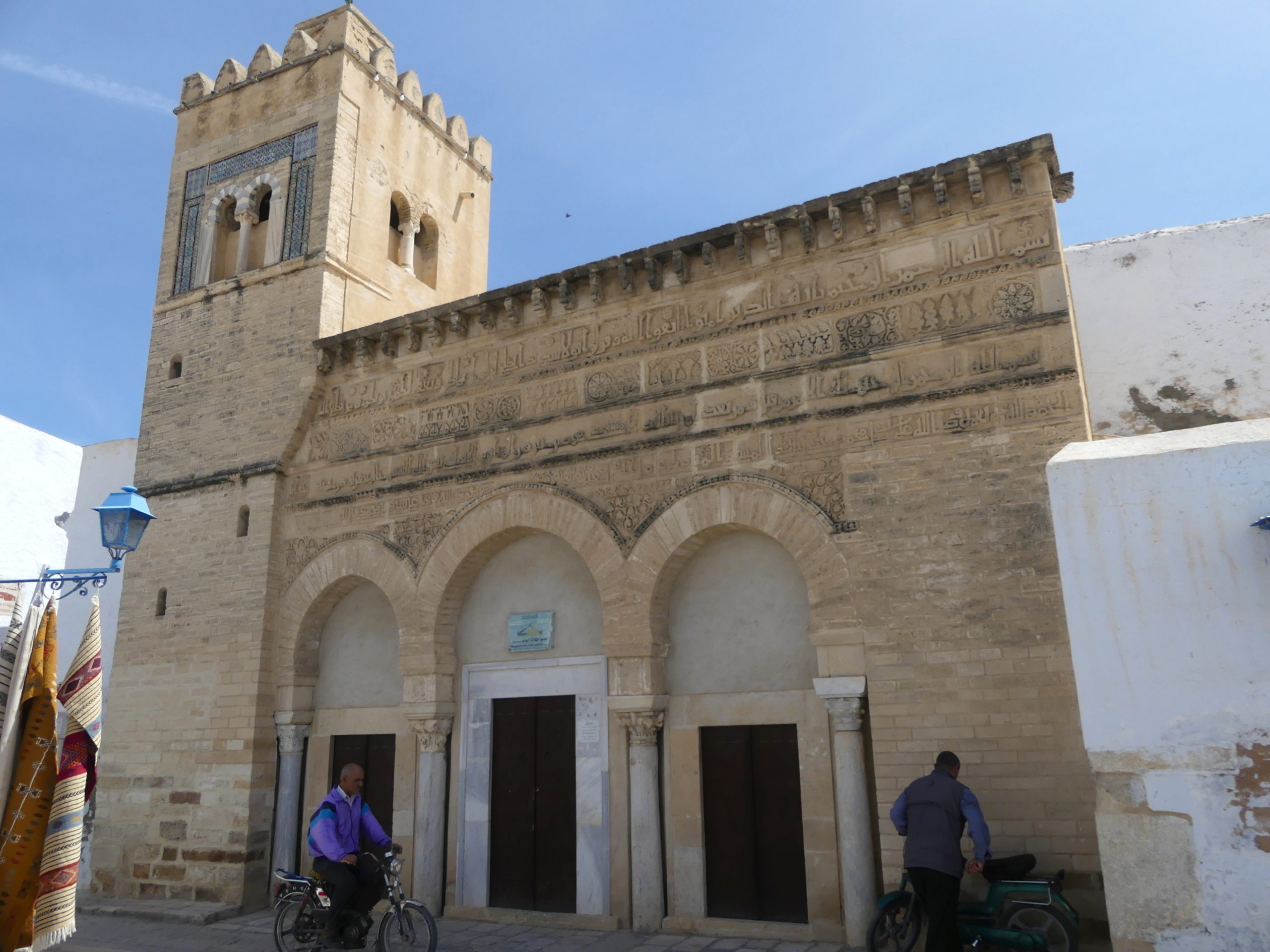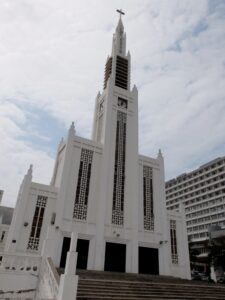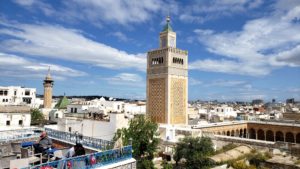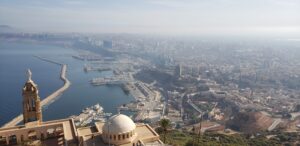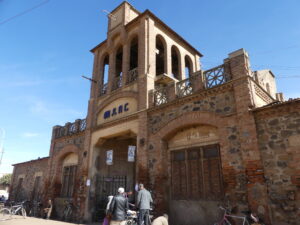In brief: Despite the contemporary bustle of these ancient towns, the origins of Islam still echo in the streets from the ancient mosques and monuments.
Two World Heritage sites in Tunisia returned us to the early spread of Islam in Northern Africa, some 1200 years or more in the past. Both the Medina of Tunis and the town of Kairouan are still lively in market activity and religious fervor. As visitors we couldn’t help but be impressed by how their rich history interweaves with contemporary life.
Medina of Tunis – Al-Zaytouna mosque
As it has for over 1200 years, the sound of prayer from the mosques accompanies residents while they pass centuries of historical monuments, houses and palaces in the Medina, Tunis’ oldest and most atmospheric district as well as a World Heritage Site. We stayed near the most revered of those mosques, Al-Zaytouna, whose founding at that time defined the very center of the Medina and, with its innumerable madrasas or teaching centers, a center of Islamic learning as well.
The courtyard of the famous mosque of El-Zaytouna, with its current form dating from the 10th century when it also served a defensive purpose against attacks from the sea. Non-Muslims are not allowed within the mosque itself, past the tiered doorway.

Based on an older design in Tunisia, the mosque was the model for the one at Cordoba in Spain, as well as many a European plaza, it seems. There are 166 columns along the side resettled from the ruins of Carthage, as well as hundreds of limestone blocks that form the outer walls of the courtyard. An old sundial and chronometer to the left (between the prayer rugs) were tools of the astronomers who monitored the progress of Islam’s lunar calendar.
This vast space contrasted dramatically with the Medina’s narrow streets and souks, which surround the Al-Zaytouna mosque. Most of the contiguous streets reveal no indication that their walls form the exterior of the mosque. Only one exterior face gives a sense of the grand mosque within. This formal portico along one exterior wall – with just a peek at the old watchtower on the far side – served also as a general meeting place for visitors and locals, as well as a marketplace for various goods. It was not, however, the usual entrance for the mosque.
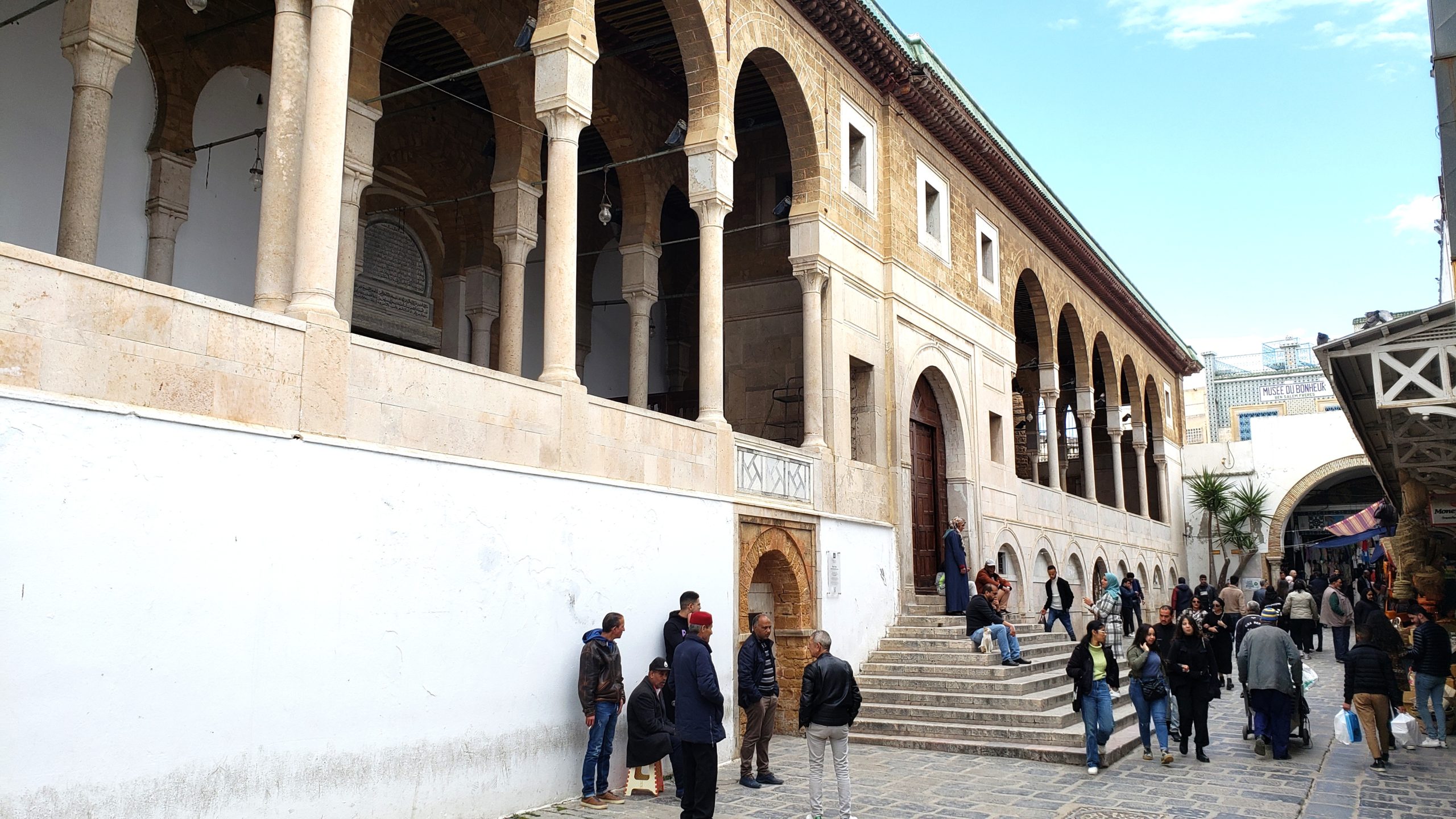
A very special door in the Medina, where interesting decorative doors are everywhere. This is an entrance reserved for the imam of the main mosque, El-Zaytouna. Its three marble lintels were re-purposed from the ruins of Roman Carthage of a thousand years before the mosque. The carved floral decoration was retained, but the figures were effaced as religiously improper.
Near El-Zaytouna mosque, the madrasa of As-Slimaniya, or Solomon, started in the 18th century as an Islamic teaching center where the students also lived. The black and white decoration is painted, but the pattern is based on the street entrance and the doorway to its mosque, each made of interlocking pieces of black and white marble. All of this work was done on site, not moved from elsewhere.
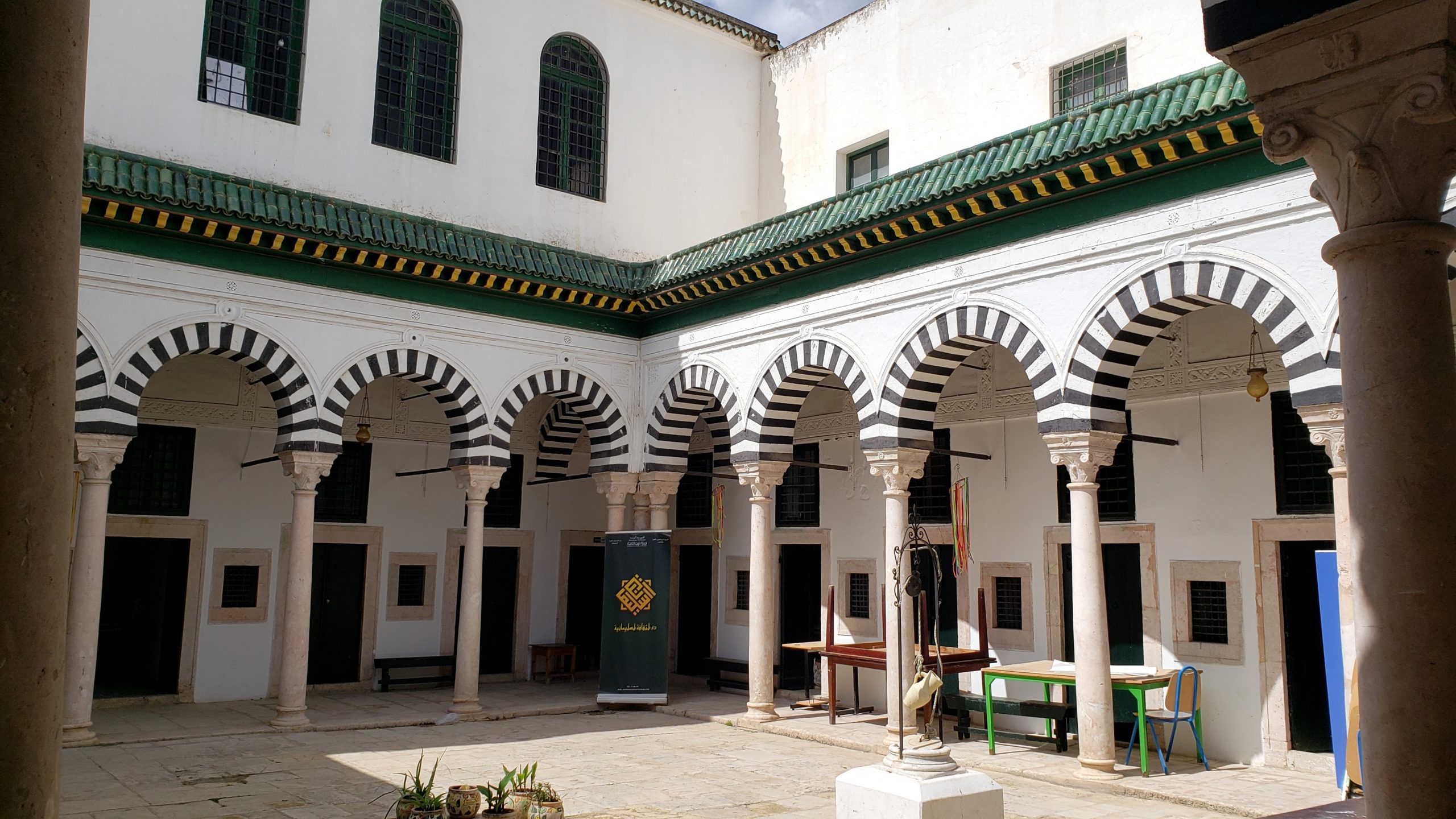
Medina at Ramadan
Now, during the holy month of Ramadan, the chants arising from the mosque have greater import, for people faithfully deny themselves food and drink – among other things – during the day, as prescribed in the teachings of Islam. Over centuries, the lowest ranks as well as the highest, whose palaces or grand houses were also here, observed the fast. The narrow, twisting streets become calm until the afternoon.
Then people bustle through the narrow lanes of the souks (market lanes) that encircle Al-Zaytouna to prepare for Iftar, the breaking of the fast, a time to spend joyously with family. During that evening meal, the streets become still again, but revive with after dinner socializing.
In preparation for the first Iftar of Ramadan, shoppers thronged the food markets, especially the olive stands like this, where various fresh greens were also available. Most families prefer to purchase the raw olives and cure them with their own concoction.
A charming covered lane through what was once an open air souk, with stalls of various sorts abutting each other. It’s very quiet early in the day during Ramadan.
And so it has been for all those years since the sand-colored stones of Al-Zaytouna first centered the Medina.
Around the Medina
(For our first looks at the Medina and Tunisia, click here to view our arrival post.)
A typical narrow street through the Medina, including an archway that uses a keystone construction along with a herringbone pattern in the bricks for added strength. These are also useful for sheltering in the rain.
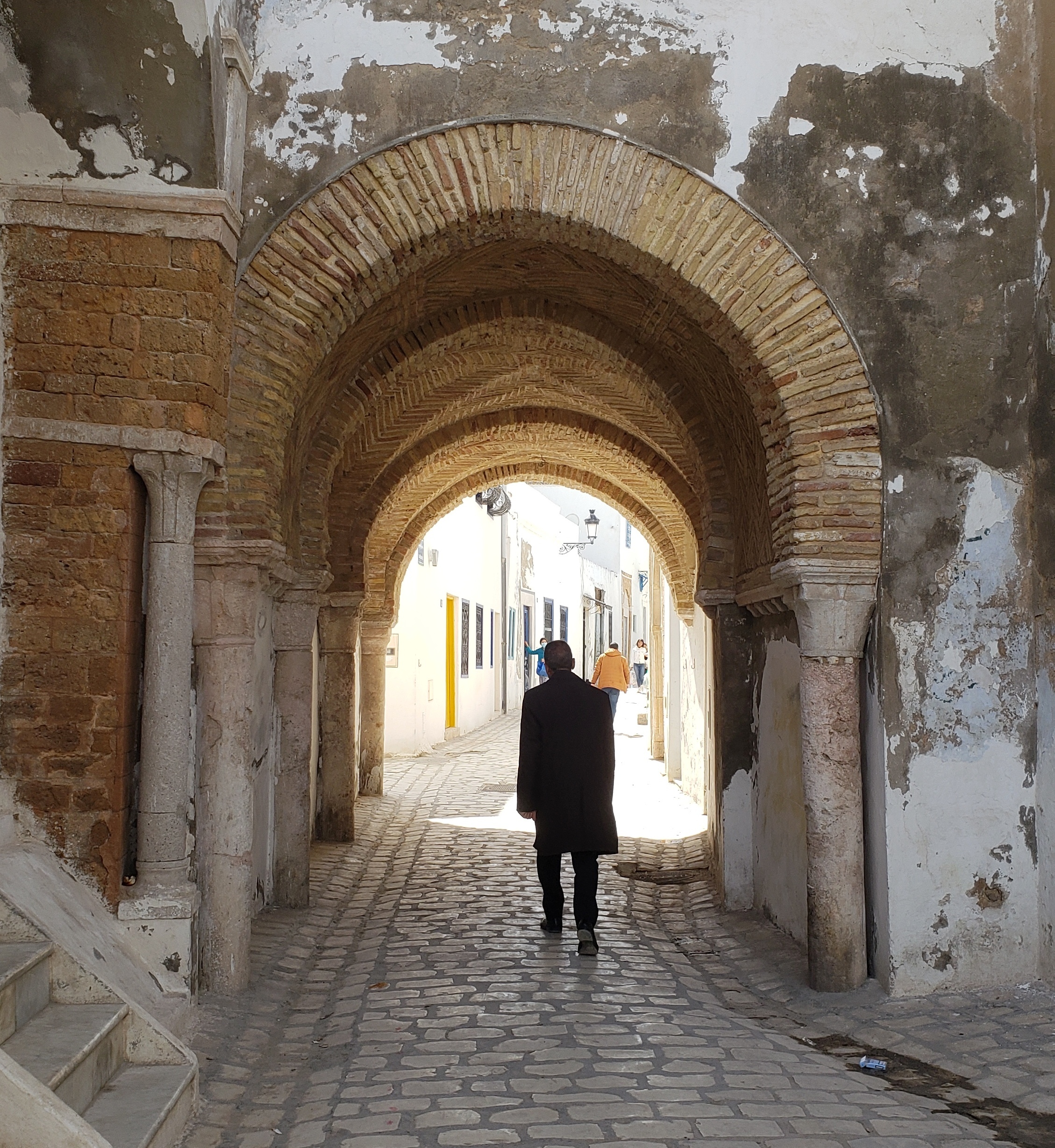
At an advantageous crossroads in the souk, the man in the middle – the grandson of the original owner, whose smiling image hangs on the wall – shows some of his hundreds of herbs and spices, oils and scents to Nancy and our splendid guide. One tiny bottle of jasmine oil dated from 100 years earlier and cost about $100.
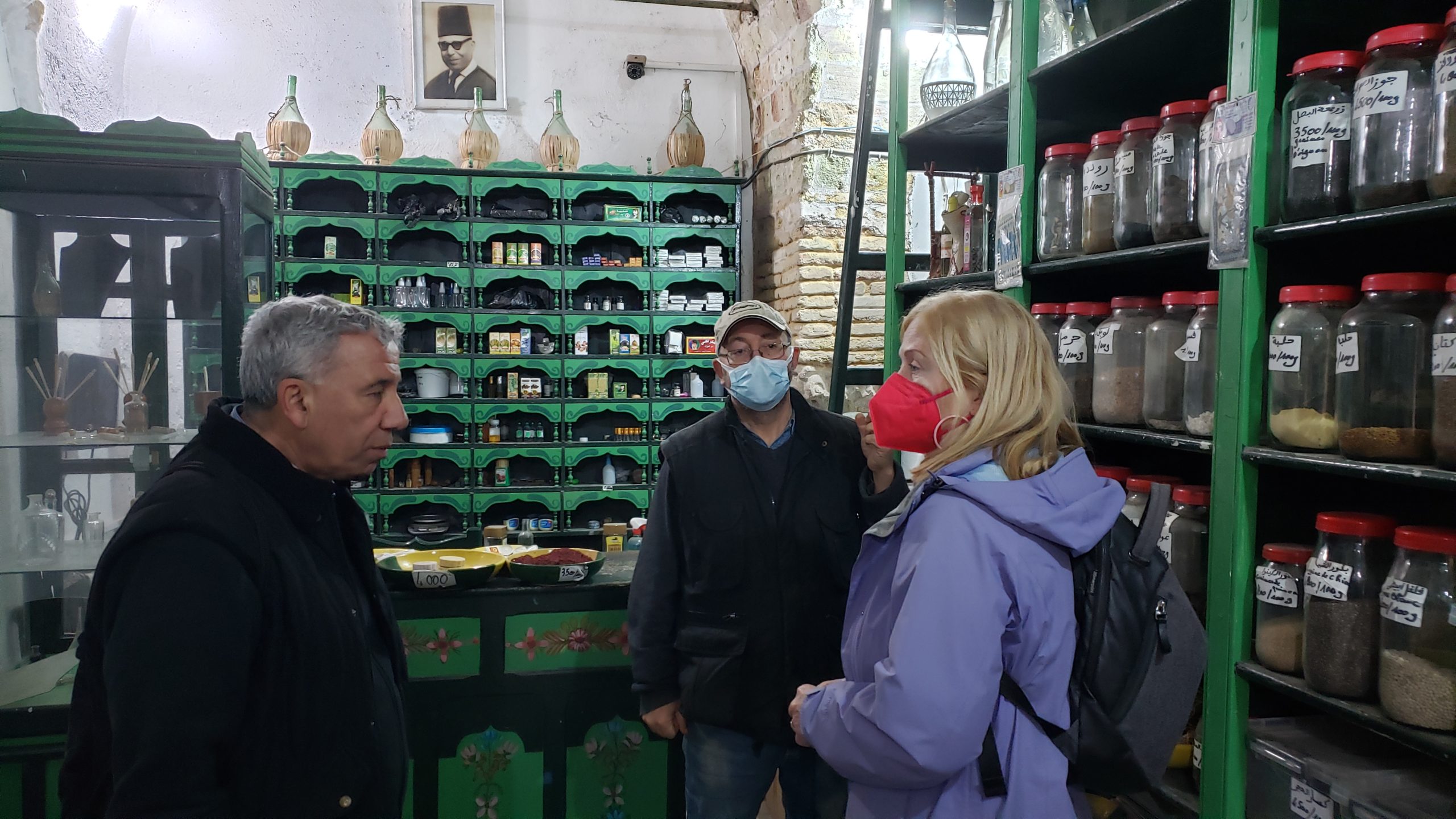
One of the four remaining gates out of the original 16 in the walls that encircled the Medina is Bab El Bhar, the eastern gate toward the sea. Now only decorative, or suitable for parking a police car, this marks the division between the wayward streets of the Medina and the grid-system of the European sector as developed by the French.
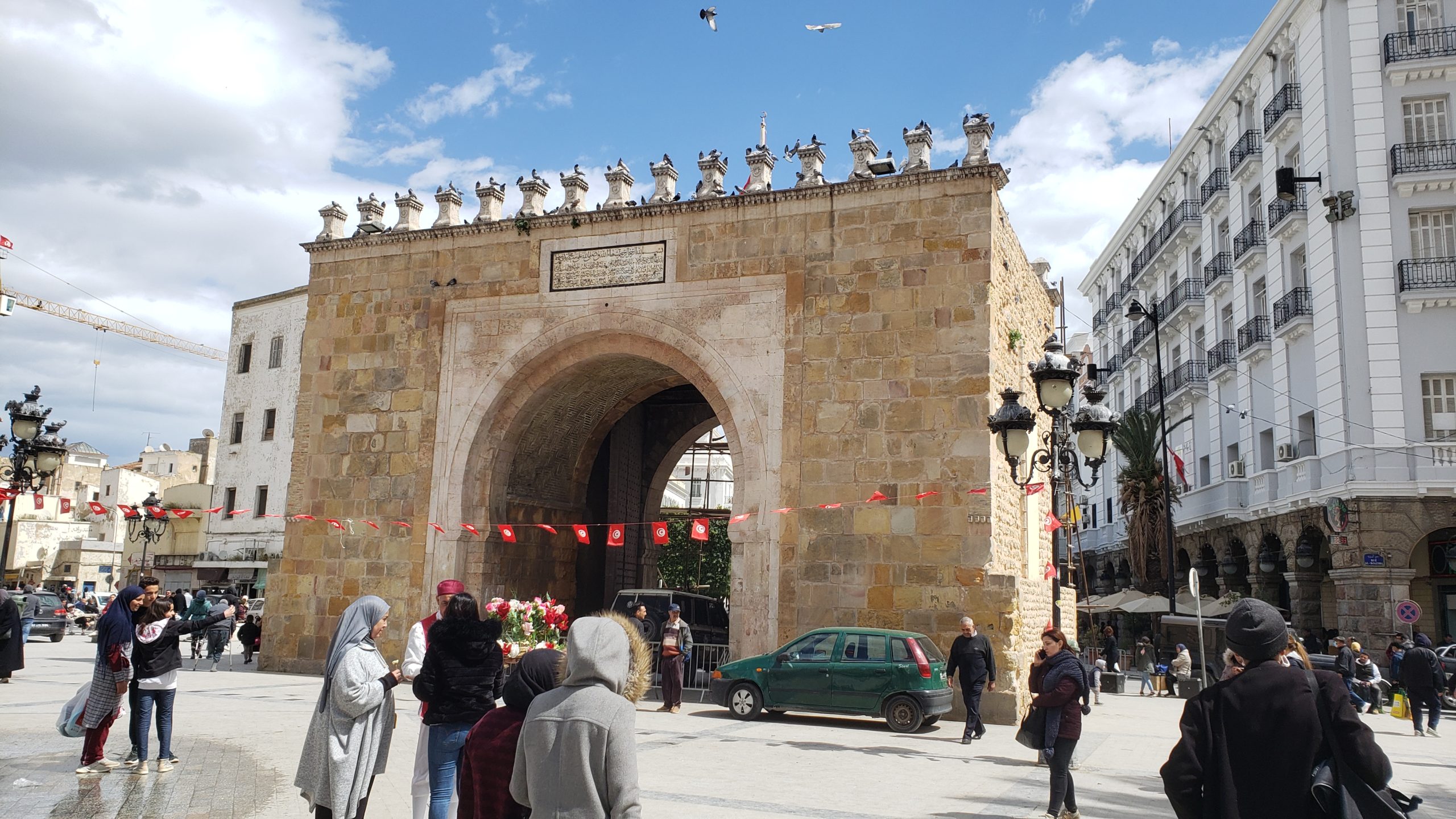
At the second large mosque of central Medina, Hammouda Pacha, we passed one of the mausoleums which entomb the imams and teachers for those who came here to study religion. This elaborate doorway is a typical sight along the streets of the Medina, but hard to photograph since the lanes are often so narrow.
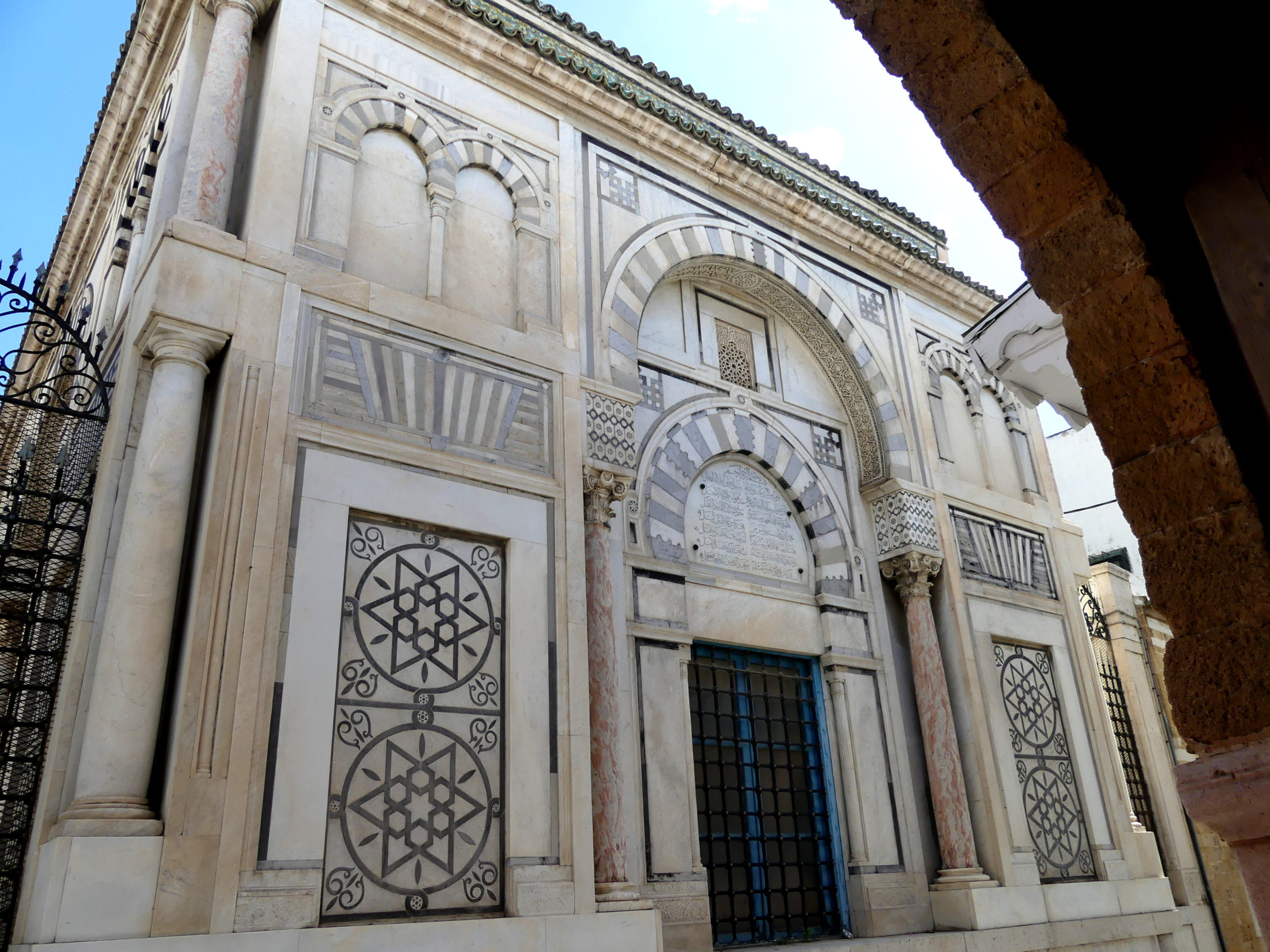
This watchtower at Hammouda Pacha, an octagonal minaret in the Turkish style, dates from the 17th century. The older tower of El-Zaytouna collapsed at the end of the 19th century and was rebuilt. This one still elegantly pierces the sky above the very narrow lanes, mausoleums, and monuments of the Medina.
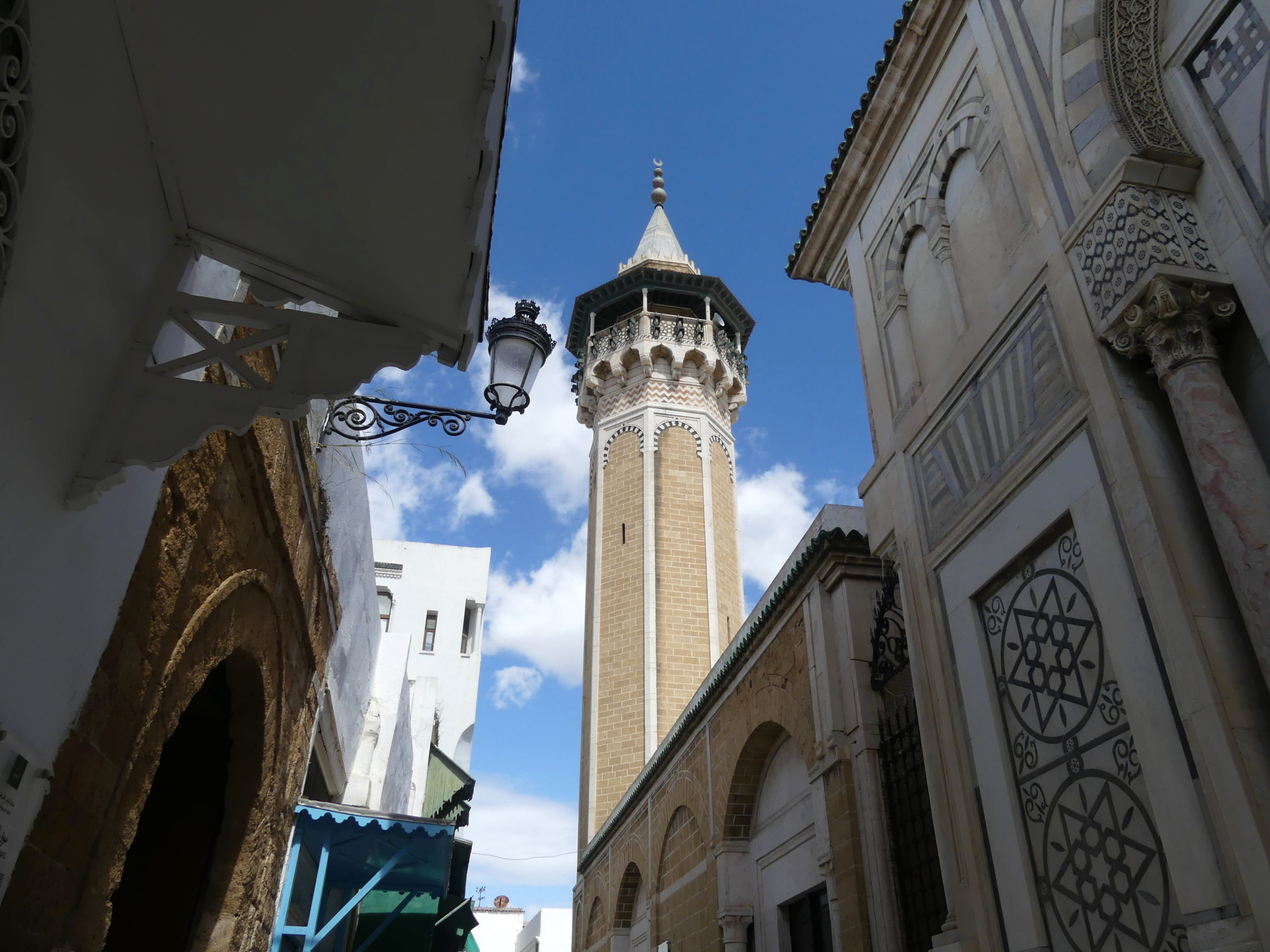
A notable palace in the Medina, the Palace of the Bey, who found dubious protection under the French. It’s at the edge of the now missing old walls and the old Kasbah, the governmental garrison.
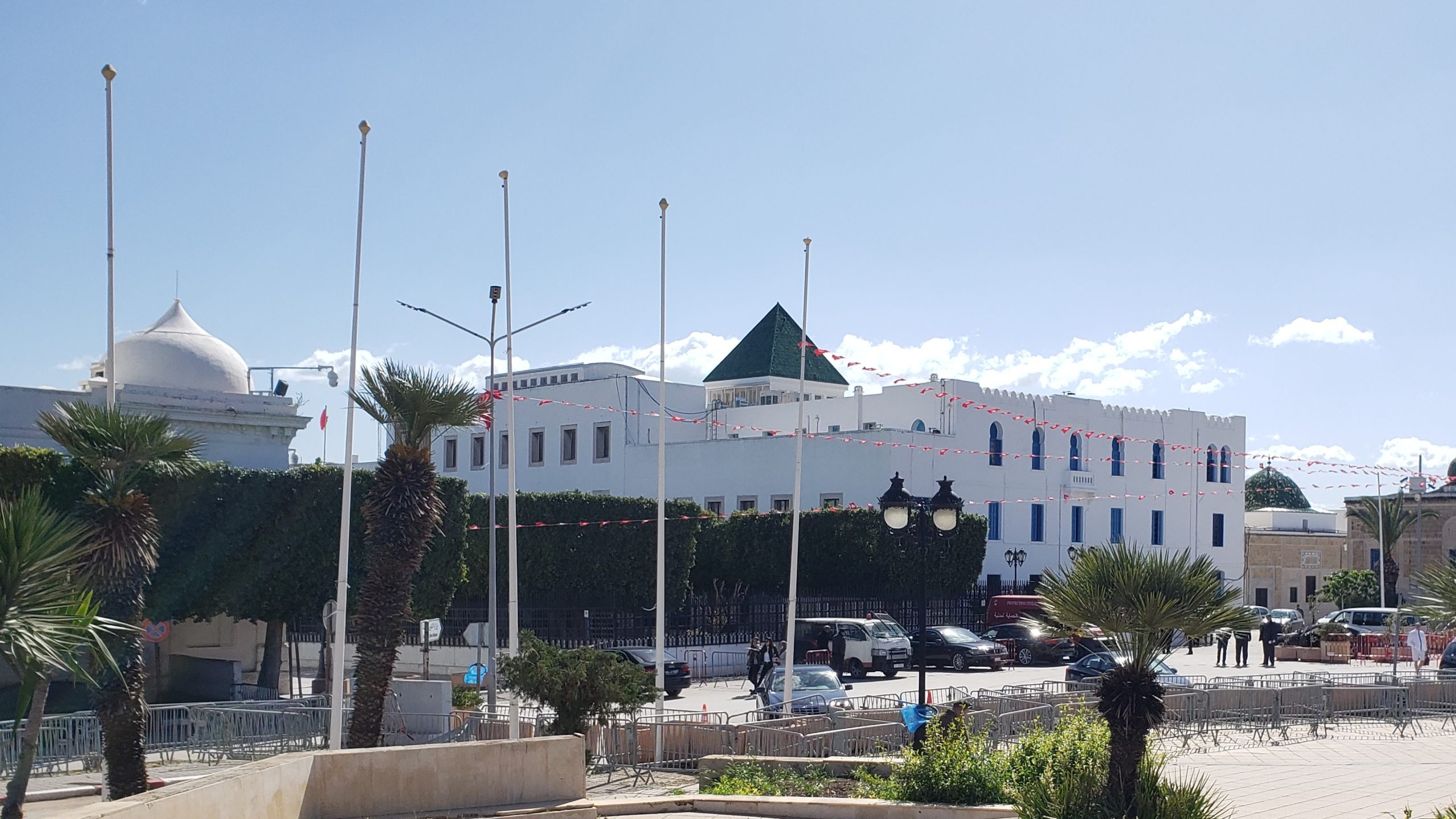
Holy City of Kairouan
Amid all the antiquities of Tunisia, the most surprising perhaps is the city of Kairouan, revered as Islam’s fourth holiest site in the world – after Mecca, Medina and Jerusalem. It is located about 150 kilometers south of Tunis and 50 kilometers west of the second city of Sousse.
The conqueror Oqba founded the town in the 7th century, shortly after Islam began to spread, at the site of a miraculous spring in the desert. By the 11th century, the powerful Aghlabids made this their capital city with 100,000 people, a trading powerhouse – eventually yielding to Tunis in power, but not spirituality.
Triumphing over the Byzantines on the coast and the Berbers in the mountains, the empire of the Aghlabids dominated the central Mediterranean at the time. Their impressive Great Mosque of Oqba served both defensive needs and as an enduring religious center. A famous medical school attracted physicians and patients alike.
Across the huge colonnaded space of the Great Mosque, our eyes were inevitably attracted to the domed atrium that leads to the huge prayer hall. The white stand to the left is a sundial, which still functions!! (of course, it only needs the sun’s movement to work.)
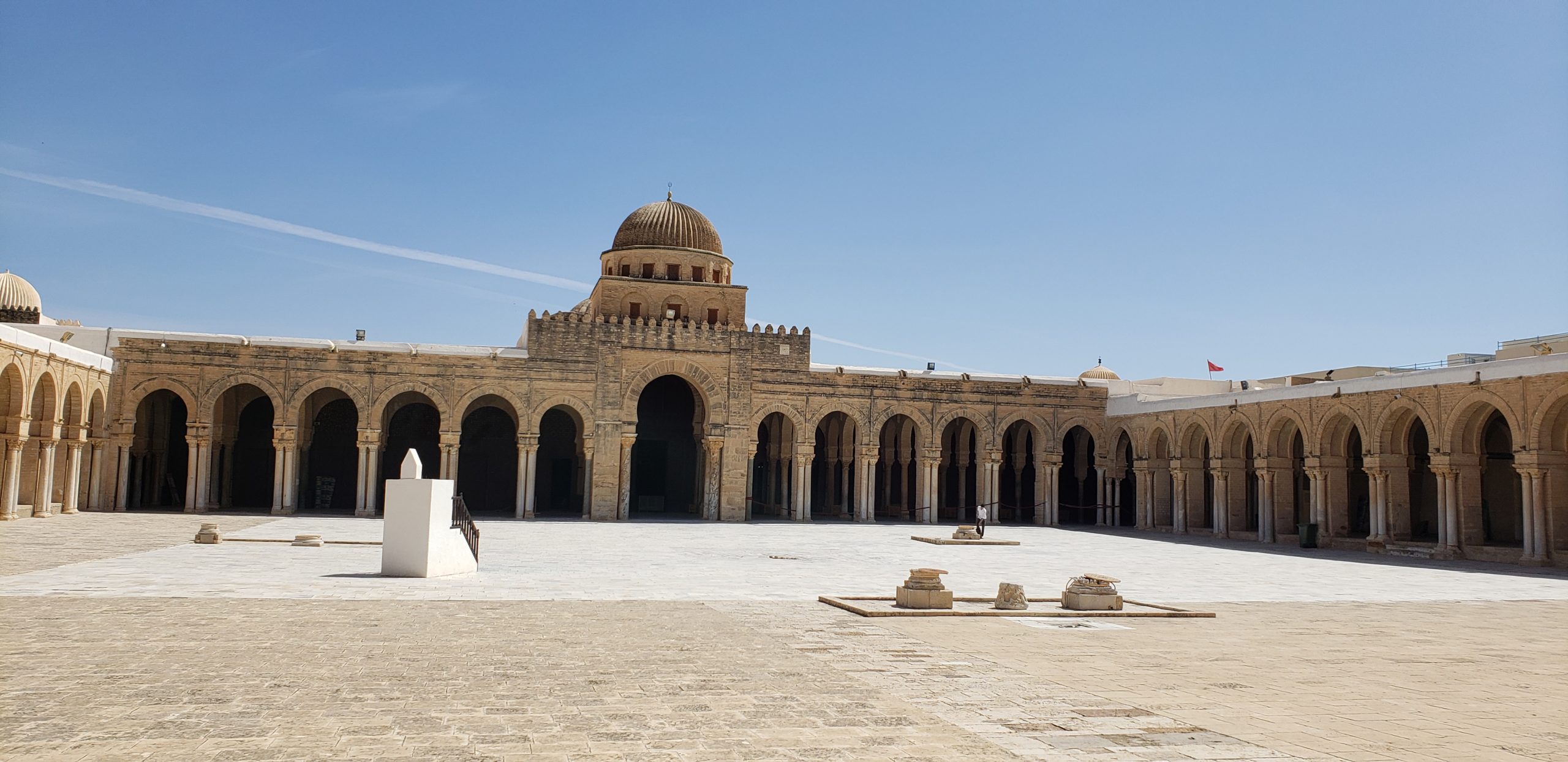
Toward the center of the plaza are several inverted pyramidal basins which collected rainwater into large cisterns below. The columns likely came from ancient Carthage.
The awe-inspiring beauty of these simple, repeated ochre arches makes the exterior aisles around the plaza of the Great Mosque breath-taking.
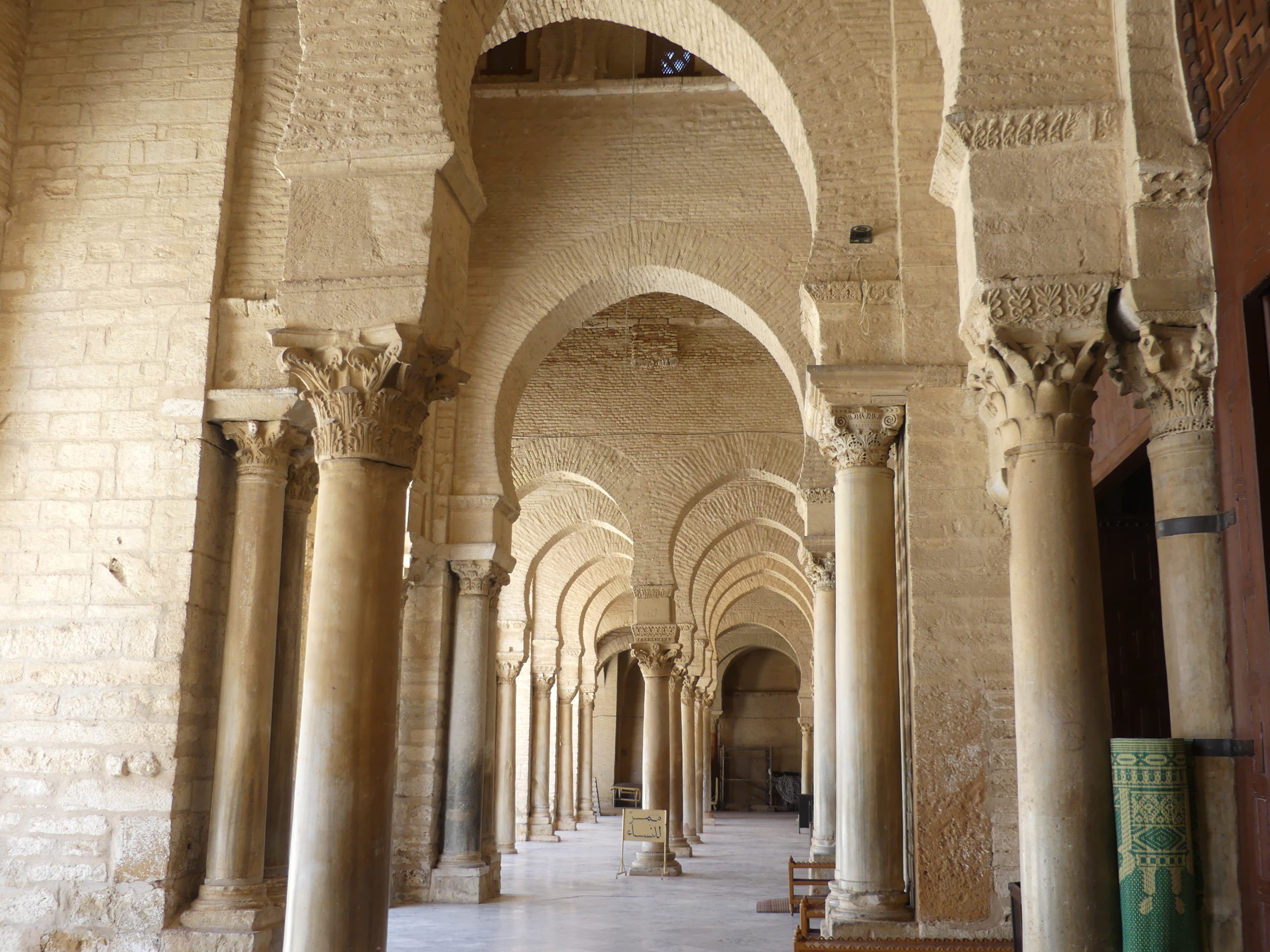
We are allowed to peak into the huge carpeted prayer hall of the Great Mosque with its seemingly infinite array of columns, graced also by charming chandeliers. It’s hard to tell from an outside view, but marbles, tile, and stylized architectural elements make the interior of the mosque artistically rich. As for the pillars, tradition says that anyone who dares to count the number of columns will be blinded. (Let’s just say around 500.)
A glimpse of the interior from another entryway made it clear that learning and study were values that continued till today. This elder remained quite focused on the book before him.
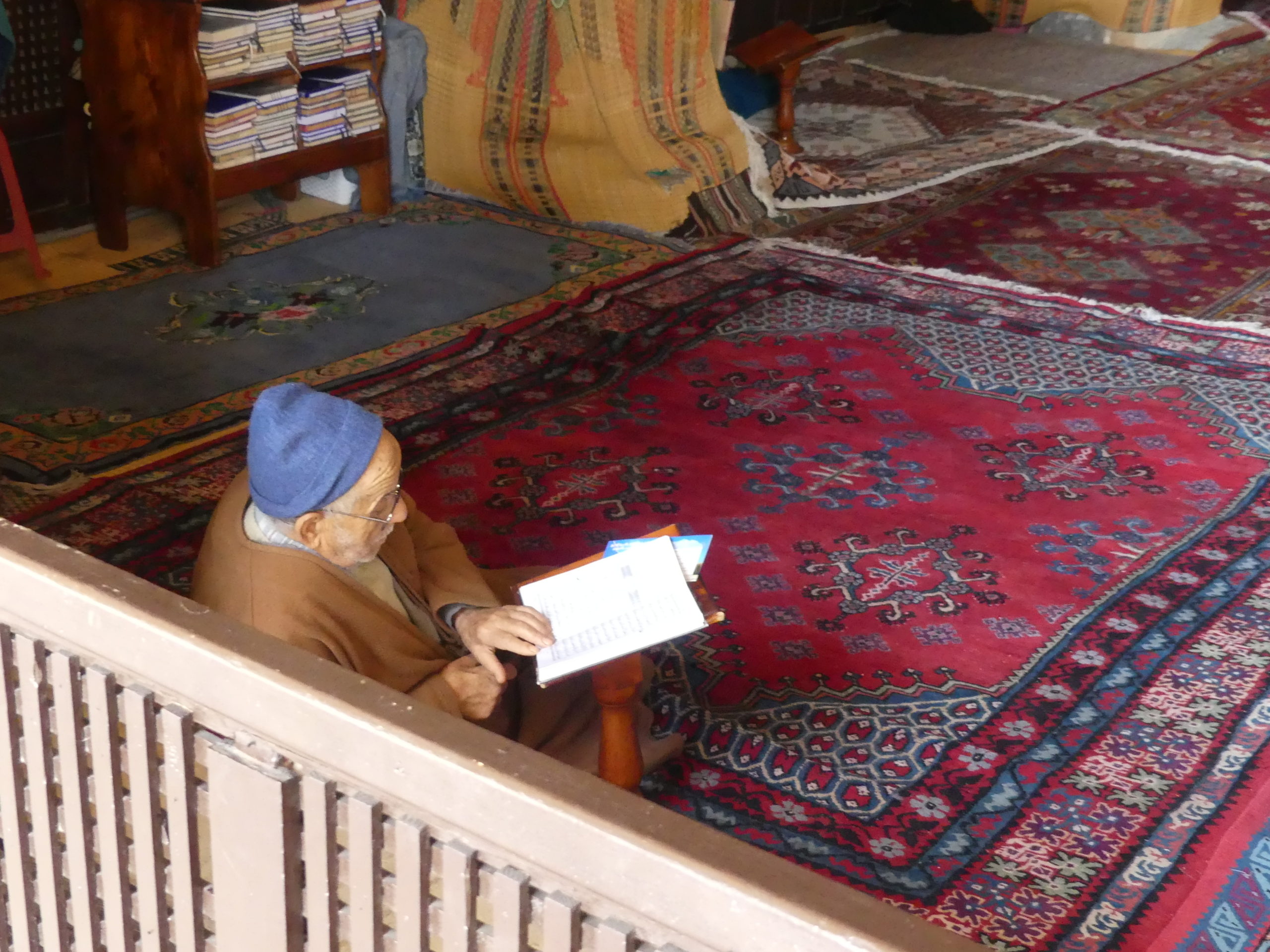
The stolid 125-meter (over 400 feet) long western wall of the Great Mosque shows its defensive prowess. But the white dome (of stylized vines) marks the place for prayer, as always. The devout enter and exit for prayers through the portal to the right.
In the past, tourists could also visit in this way, but no longer. The northern wall includes the looming minaret whose base dates back to the Mosque’s origins. Just to its north, hundreds of dazzlingly white tombs of various geometric shapes make an eerie kind of graveyard.
Subsequently, many Sidi (holy men) came to Kairouan and had been honored by a plethora of fascinating mosques and tombs across the old town. In walking through this World Heritage city, we felt we were tracing ancient paths of both history and religious fervor.
At the 14th century tomb of Sidi Abid al-Ghariani, within the Medina or old town of Kairouan, you can walk around the dark room where a metal enclosure protects the saint’s burial site, under an inverted multi-level pyramid of elaborately painted wood.
But we thought this picturesque inner courtyard, with its multiplicity of decorative elements, was especially appealing. The two levels demonstrate that this was a teaching institute for religious students even before the holy man was buried here.
The cupola in this arched passageway between the two main courtyards of Sidi Sahbi’s tomb is dazzling, decorated with geometric and floral motifs intricately formed in the stucco. The detail is striking; we were so delighted visually that we didn’t want to leave the space.
It is part of a later-built mausoleum for one of the most important holy men honored in Kairouan, Abu Zama’a al-Balawi or Sidi Sahbi – a companion of Mohammed himself. This Spanish-Moorish technique is just one of many artistic styles used within the mausoleum.
The inner courtyard at the mausoleum of Sidi Sahbi, the companion of Mohammed. To see the burial site, you pass through a small door in the corner of this space, but we were not allowed. The courtyard itself though is a harmonious blend of decorative elements, from the white stucco geometric and floral sections, to the marble arches and the delicately carved facades they support, and the richly colored tilework along the walls.
Walking the streets took us back in time and delivered charmed sightings like this one: a simple, old whitewashed minaret, still active with its loudspeaker for calls to prayer. These lanes once buzzed with the many tradesmen of the old city, and still do with hawkers and textile weavers.
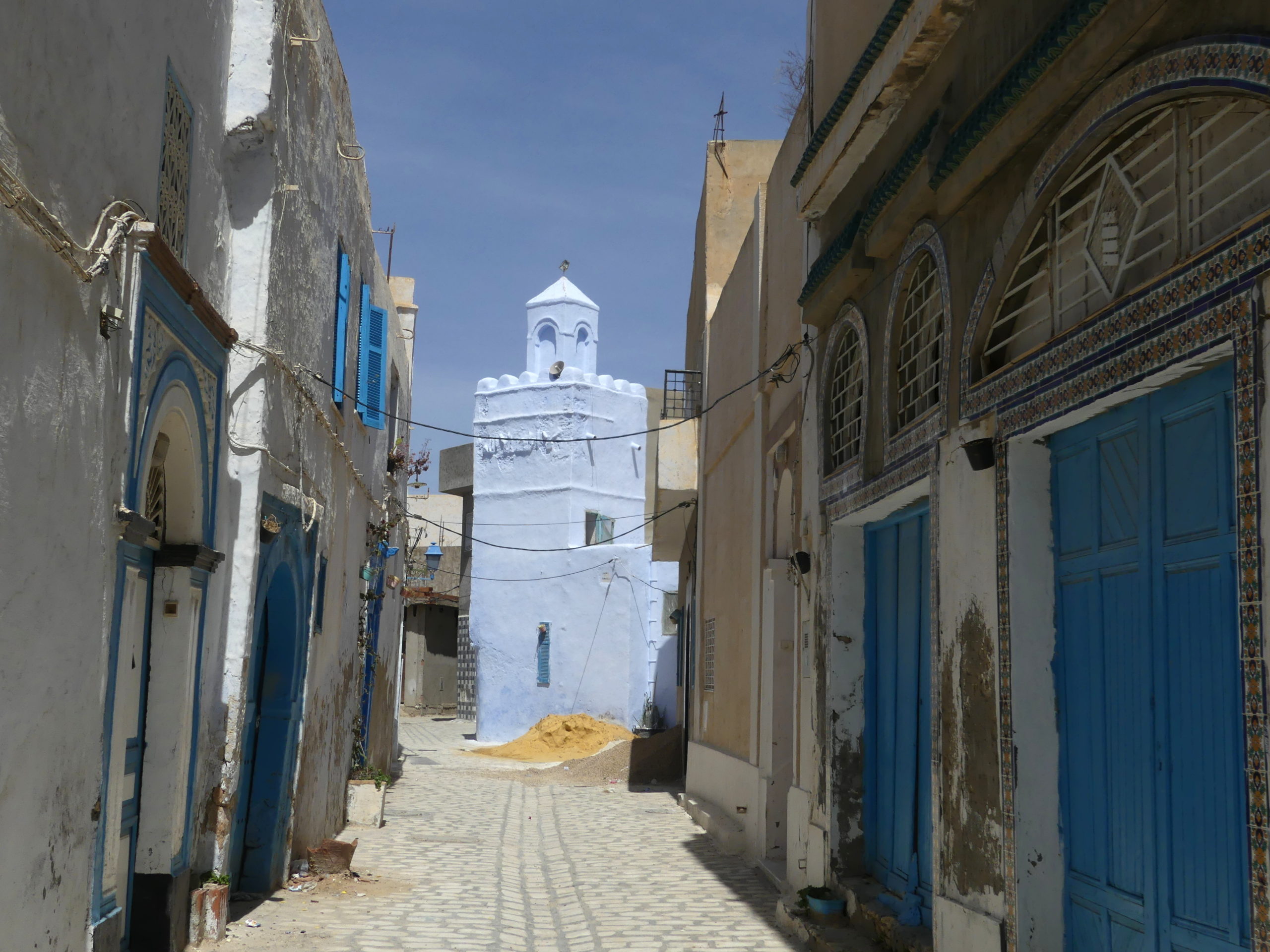
Looking a bit like a compact Romanesque villa, this is the aptly titled Mosque of the Three Doors dating from the 9th century, an Aghlabid construct and one of the oldest in the world.
The doors get the attention, but we were most attracted to the four friezes sculpted with elegant Arabic script from different time periods.
As the motorized cyclists (and the tapestry shop on a nearby corner) demonstrate, life goes on as normal around the mosque – and the streets of Kairouan – today.
(To enlarge any picture above, click on it. Also, for more pictures from Tunisia, CLICK HERE to view the slideshow at the end of the itinerary page.)


